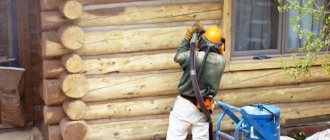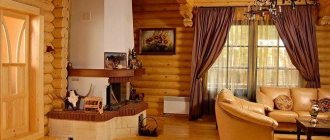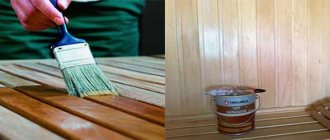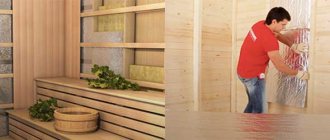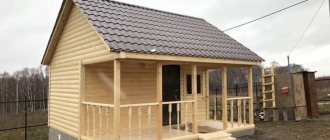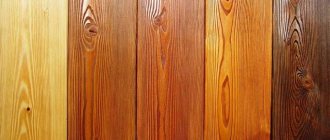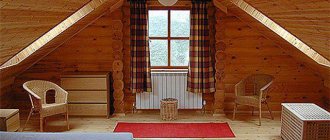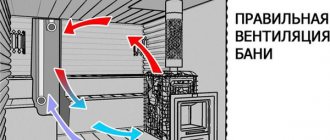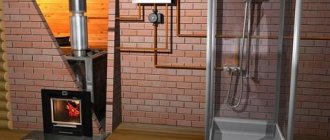A bathhouse is a structure that is subject to increased loads throughout the entire period of its operation, primarily due to high humidity and sudden temperature changes. All this has a negative impact on the wood from which the bathhouse is built. In addition, wood itself is sensitive to the external environment. For example, wood is deformed under the influence of seasonal changes in temperature. Thus, to extend its service life, wood needs protection. How a log bathhouse is processed will be discussed in this article.
Types of protective compounds and requirements for them
It should be noted right away that after treating the walls with a protective composition, the appearance of the building should not deteriorate. It is important that the wood retains its natural appeal. The protective layer should not negatively affect the technical characteristics of the wood - air permeability should remain at the same level.
Also, the protective layer must ensure that the wood can withstand atmospheric influences (precipitation, sunlight, temperature changes), fire and insect pests.
Treatment with impregnations allows you to reveal and emphasize the wood grain
All these issues cannot be solved only by treating the walls with antiseptic compounds. Only comprehensive treatment will help. Using the following means:
- Antiseptics that prevent the appearance of mold and mildew.
- Antiperenes , which increase the fire resistance of wood. During processing, the substance penetrates the top layer of wood and is released when the surface is heated, forming a protective film.
- With the help of varnishes and paints, wood can be protected from atmospheric moisture and sun. To preserve the wood texture and shade, it is recommended to use colorless compounds. Sometimes a colored pigment can be added to enhance the tone of the wood.
Expert opinion: Masalsky A.V.
Editor of the “construction” category on the Stroyday.ru portal. Specialist in engineering systems and drainage.
To ensure that the treatment is carried out evenly and there are no missed areas, tinted fire retardants and antiseptics are used. There are also colorless compositions that can be tinted if necessary.
The use of protective compounds and coatings allows you to preserve a wooden frame in its original form and extend the service life of structures. There is no other way to preserve the shade and texture of wood. Painting with alkyd compounds and varnishing is only a temporary measure. At the same time, the “breathing” ability of wood with repeated staining is significantly reduced.
The treatment of bath walls is carried out in stages:
- First, the walls need to be prepared - clean and sand the outer layer. At this stage, the damaged wood is removed, the surface becomes smooth - this will allow the impregnation to be applied evenly and ensure its maximum penetration into the structure of the material.
- Then the walls are completely treated with protective compounds several times. Each layer is applied after the previous one has completely dried.
- The last layer is designed to protect the wood from external influences (paint, varnish, stain).
Initially, the logs from which the bathhouse will be built are treated with protective compounds - antiseptics. When the log dries to the optimal moisture content, substances are applied to its ends that prevent deformation and cracking of the natural building material.
Primary processing is carried out at the stage of assembly of the structure
It is a mistake to think that this processing is sufficient. Indeed, during the construction process, logs or beams are subject to adjustment and trimming, so the finished structure also needs careful processing.
Note! The surface of the log house is processed several times. First, immediately after shrinkage. Then after two or three years. The next time occurs after four to five years, when the effect of the protective impregnations weakens.
But these are only theoretical recommendations. In fact, the protective layer weakens much faster and this depends on the climatic characteristics of the construction region.
Why do you need to paint the outside of a wooden bathhouse?
- For protection against weather conditions. Sun, precipitation, wind - all this does not improve the tree;
- To protect against temperature changes emanating from inside the bath, which also affect the durability of the material;
- For protection from various biological lesions;
- For a more aesthetic appearance.
Points 1, 2 and 3 serve to extend the life of the wood base, and this is the main thing. And point 4, for some, is a controversial point. Someone will say, how can the color of paint be better than the texture of natural wood...
Painting of the log house must be preceded by the application of a primer coating, an antiseptic and a fire retardant compound (pyrine retardant). It is important. The antiseptic will create protection against wood insects, fungal mold, rotting and other things, antipyrine, and increase the fire resistance of the structure. Both substances can be chosen either in the form of a colorless substance or an enriched color.
By the way, there are some paints that contain antiseptic and water-repellent impregnations. According to many experts (who always play it safe), it is better to perform priming as a separate process.
And after sanding (when the wood loses its roughened layer and becomes easily accessible to all kinds of biological damage), this must be done immediately.
Before treating with protective substances, you need to check the quality of the log caulk and, if necessary, bring it into compliance. It is worth considering that the ends of the log house absorb moisture more strongly and therefore it is recommended to apply two or three additional layers to them.
Preparatory stage: surface grinding
Before treating wooden walls with protective compounds, as noted earlier, they are sanded. This is done in order to remove the worn, mechanically damaged top layer.
The abrasive blade of the tool cuts off several millimeters of the wood layer
This is a mandatory procedure, as a result of which it is possible to cut off the porous layer of wood saturated with moisture. If it is not removed, it will prevent the penetration of protective compounds into the wood. And the air that is in the pores will not allow you to evenly cover the wood with varnish or paint - bubbles will appear on its surface.
Sanding of logs is carried out in stages:
- First, the surface is cleaned of large loose particles and bark, if any remains, using a disk brush with metal bristles.
- Then the areas near the junction of the two crowns are polished. This part of the work has to be done manually, since the joint is difficult to access. You can use the tool at low speeds and a sandpaper attachment.
- At the final stage, the front surface of the log is polished. The tool should operate at medium speed. The diameter of the abrasive disc should not exceed 15 cm. It is necessary to carefully process the surface of the wood, cutting off a layer of no more than 2 mm.
To avoid creating unwanted defects on the surface of the logs due to inexperience, it is recommended to use a special tool - a vibrating or belt sander .
Sanding is a dusty process, so work must be done using personal protective equipment
Note! Logs are sanded every time they need to be treated with protective compounds. Each time, after removing the old layer, the wood grain appears in a new way.
Wood preservatives
Due to the ever-growing popularity of wooden houses, more and more manufacturers are appearing on the market offering various means of protecting the structure both inside and outside. Much attention is paid, first of all, to environmental friendliness and safety for humans. The ability to preserve wood in its natural and original form is also among the first tasks. The modern product guarantees reliable protection from adverse weather conditions, such as rain, snow, ice, etc. Protection from insect pests is also mandatory on the list.
So, to process a log house from the front side, four tools are needed:
- Antiseptic.
Antiseptic agents significantly increase the resistance of wood to the adverse effects of moisture. Due to the fact that the antiseptic is able to penetrate deep into the log, reliable protection is formed against almost all types of mold and fungi. Manufacturers offer antiseptics in various forms, which you can choose based on personal preferences: oil, varnish, wax. - Fire retardants.
Fire retardants create a fire retardant coating that prevents fire from spreading across the surface. A special protective film is formed on the wood, which comes out of the log at high temperatures. Such a film guarantees the impossibility of rapid ignition in the event of a fire, thereby insuring against open fire for several hours. - Impregnations and solutions
. Impregnating agents allow log structures to remain smooth and even for a long time, without any cracks. The attractive appearance is complemented by protection from excess moisture. Thanks to the protective film, a water-repellent barrier is created. Available in various forms; popular types include primer and oil. - Finishing agents
. Finishing agents are usually used more for decorative purposes. Using these tools you can quickly and easily change the appearance of the structure. Paints and varnishes are able to give the desired, necessary shade, while reliably protecting against premature fading in the sun, or, conversely, from the darkening that occurs with wood over time.
Many manufacturers currently offer universal products that can combine all of the listed protective equipment at once. But as practice shows, the effectiveness of such products is unreasonably low, so you should not skimp on quality and durability. It is better to immediately acquire high-quality products, each responsible for a specific protection. All products must have a quality certificate guaranteeing their environmentally friendly and safe use for humans.
Compositions for external treatment
To impregnate the walls of log and timber baths, special or universal compositions are used. The quality of the result depends on the technical characteristics of the product and compliance with the technology of its use.
Tinting varnish with wax for exterior and interior use
Wood preservatives are:
- In the form of quick-drying impregnations with a water base.
- In the form of combined formulations that simultaneously perform the function of an antiseptic and fire retardant.
- In the form of protective components in oils and varnishes.
Note! When applied, protective impregnations emit a pungent odor, so it is recommended to use personal protective equipment during operation.
Antifungal protection
Even if cedar or oak was used to build the bathhouse, the wood needs to be treated with antiseptics. The lower crowns are especially vulnerable to moisture. Russian-made compositions have a complex effect in terms of suppressing the formation and proliferation of mold, as well as destroying insect pests.
This is what mold damage to logs looks like
Imported preparations are represented by emulsions and water-based formulations. Some preparations have an acrylic or oil base. When treating logs with such compounds, you can not only provide protection against fungus, but also create a water-repellent film with a satin shine on the surface.
How and with what to treat a log bathhouse
All this fuss with chemical reagents and paints and varnishes is primarily necessary in order to preserve the wood and the original appearance of a freshly built log house. There is no other way to preserve the color and texture of the timber other than to treat the log house with protective coatings. Conventional painting of a bathhouse with alkyd enamel or varnishing gives only a temporary and far from complete effect. You can’t often repaint a log house; it’s not a fence; increasing the layer of paint can only make the situation worse.
A professionally planned procedure for treating a bath outside involves several stages:
- Preparing the surface of the log house walls, cleaning and polishing the outer layer. In this case, already damaged layers of wood are removed, which prevent the timber from being treated to the maximum depth of penetration of the reagent;
- Impregnation with several chemical reagents. You will have to sequentially treat the walls of the bathhouse, from the roof to the foundation, in several stages, with rather toxic chemicals. They cannot be mixed, and before treating with each subsequent solution, the walls must be thoroughly dried to the initial level;
- Applying a protective varnish or paint layer. It is not enough to simply treat the walls against fire, bugs or blue rot; you will need to protect the wood from the main negative factors - solar heat, ultraviolet radiation and moisture.
It is clear that when preparing material for construction, be it timber or logs, the wood must be treated to protect it from pathogenic microflora and insects. In addition, after the timber or log has gained the necessary moisture, the ends of the workpieces must be treated with protective impregnation in order to prevent cracking and deformation of the material.
A well-maintained log bathhouse can be easily recognized by the color and shine of the walls
Therefore, sometimes the owners of the future log bathhouse believe that this is quite enough to protect the new building. It does not take into account the fact that when assembling a log house, the locks are cut at the corners and part of the outer layer is cut off. All this significantly weakens the surface, so the log house needs to be processed and done professionally and competently.
Locks are treated with an antiseptic before assembling the bathhouse frame
Important! In theory, surface treatment of a residential building’s log structure should be performed at least three times.
The first time - upon completion of the shrinkage processes, then - 1.5-3 years after the start of operation of the bath. The third time you need to treat the log bathhouse after 4-5 years, when most impregnations and coatings will lose their protective effect.
You can often find materials for processing a wooden bath with a warranty period of protection for 10 years. This is all a theory; in reality, impregnations lose their properties much faster. It all depends on the area in which the bathhouse is located, how often it rains and how many sunny days a year there are. Each heating of the log house, especially the spring-summer season, causes degradation of the protective coating, so it is better to process it more often and not skimp on materials.
If the bathhouse frame is assembled from aspen, then the timber often has to be pre-treated with bleach
Sanding a log bath
Before processing the walls of the log house, it is necessary to get rid of the old outer layer of wood, which has greatly degraded during storage and preparation for the construction of the bathhouse. Essentially, this is mechanical processing or cutting off a thin layer with an abrasive cloth or, most often, sandpaper glued to a wheel.
It is also necessary to cut and process wood at the joints of timber
It is necessary to sand the walls of the bathhouse. In this way, it is possible to remove the porous outer layer, in which a lot of air and water vapor have accumulated. If you process a log house without resorting to sanding, the air will not allow the reagent to penetrate deep into the thickness of the wood. And later, when it comes to painting the timber with a protective varnish, due to the air on the surface of the log house, the result will not be a smooth surface, but a scattering of frozen microbubbles.
Bath crowns need to be processed in three stages:
- Cleaning the surface of the timber with a disk brush with bronze bristles. The device is placed on the shaft of the grinder and the thickest and most powerful deposits on the surface of the wood are removed, including remnants of bark and clearly damaged areas;
- Grinding the surface adjacent directly to the inter-crown gap. These areas are the most difficult to access, so they try to process the wood either manually or using a low-power machine with a plastic disc of sandpaper mounted on it;
- The last stage is grinding the front surface of the timber. In this case, the crowns of the log house can be processed with a medium-power grinder with an abrasive disk with a diameter of no more than 150 mm.
Important! The last stage is considered the most difficult. It is necessary to feel the operation of the power tool with your hands, because you need to cut and process a layer literally 1-2 mm thick.
If you don’t have experience, you can easily create scratches and burn marks on the surface of the timber. Therefore, many craftsmen prefer not to take risks and process the front parts of the timber using a vibrating or belt sander. Sanding will have to be done every time it comes to updating the protection of log wood.
In addition, stripping the old layer allows you to update and reveal the pattern of wood fibers on the walls of the log house. The sauna box seems to be transformed, and after applying a protective transparent varnish, it becomes more and more like a new, newly built chopped steam room.
How to cover the outside of a bath house
Chemical reagents used to protect log and timber buildings are conventionally divided into three types:
- Water-based drying impregnations;
- Complex or universal formulations. Such a solution can simultaneously protect against fungus and have fire-fighting properties;
- Protective additives in impregnating oil and varnish compositions.
The effectiveness of impregnating materials may vary in each specific case. It is allowed to treat a log bathhouse with both special and universal solutions; the nature of the impregnation does not matter. Most often, the result depends on the chosen brand and manufacturer of the protective agent, as well as how accurately the processing technology was followed. It is no secret that working with foul-smelling and harmful reagents is not very comfortable, so some log house owners prefer to process the sauna box using a simplified method - in one pass.
Most often, the antiseptic is sold in concentrate, so before treating the timber it is diluted with water almost ten times
Antiseptics for baths
Without special sanitary impregnation, it is very difficult to protect a log house, even one made of oak or cedar, so no matter what kind of wood or type of timber the sauna box is assembled from, in any case, the first layer must be treated with bioseptic solutions. Especially for the lower crowns of the bathhouse box, which often get soil particles during rain.
There are more than enough options for solutions for processing timber:
- Among the Russian drugs are “Aqualak-Senezh”, “Rogneda-Biosept”, “Wood Healer”, “Veft-Monolith”. All these are solutions of complex action, designed to inhibit mold, mildew, and destroy woodworm colonies;
- Imported drugs - Tikkurila, Belinka, Pinotex, both water-based and in the form of emulsions. The effect is higher, the validity period is approximately the same as that of Russian reagents.
There is a whole class of antiseptics based on acrylic and oil. The same Pinotex Classic from the company Sadolin or Vinha from the Finnish Tikkurila. If you treat the log house of a bathhouse, then in addition to preventing the growth of mold and rot, the walls acquire a characteristic satin shine due to the formation of a water-repellent film.
Fire fighting equipment
Almost all fire retardants are presented either as dry mixtures or aqueous solutions of metal salts. As a rule, these are complex compounds of nickel, chromium, iron and copper. After being applied to the surface of the timber, the solvent base dries, and the salts remain on the walls of the bathhouse.
You can test the effectiveness of a fire retardant yourself.
The fireproofing impregnations themselves are quite toxic and can cause severe allergic reactions, so it is best to treat the wood with a spray bottle in several passes. In this case, the use of a respirator, safety glasses and gloves is mandatory.
It is necessary to treat a log bathhouse with a fire retardant from a distance of at least a meter
Significant disadvantages of fire retardants include their rapid leaching from solid timber with ordinary rainwater, so fire-prevention impregnations are applied as the first layer for further treatment with a bioseptic and protective varnish.
Impregnation for baths outside
Another class of protective materials is oil-based impregnation. They are used for special conditions, for example, in a situation where a log bathhouse is supposed to be installed in a climate zone with a sharp difference in daily air temperature.
If you treat a log house with oil, the fiber pattern always becomes contrasting
Most oil preparations easily penetrate into the thickness of the timber to a considerable depth; they create a continuous elastic film that protects the walls of the bathhouse equally well, both in extreme heat and in severe frost. The only disadvantage of oil impregnations is that it is recommended to process them in conditions of low air humidity, otherwise condensation or water vapor will quickly squeeze out the oil from the porous surface of the bath wood.
Application of paints and varnishes
Not every paint is suitable for painting a log house. When choosing it, they take into account, first of all, the degree of vapor permeability of the decorative layer, the type of solvent - it can be organic or aqueous, and elasticity.
The walls are treated in several layers. The color should emphasize the natural pattern and texture of the wood. Therefore, you can choose not even a tinted composition, but a translucent or transparent composition.
The main thing is that wood paint must be vapor permeable and not impede the passage of water vapor. Over time, under the influence of moisture coming from the inside, the sealed coating will collapse, become covered with bubbles and begin to peel off. Therefore, when purchasing paints and varnishes for a log house, you must carefully read the information provided by the manufacturer on the packaging. The throughput should not be less than 120 grams per m2.
Acrylic vapor-permeable varnish for exterior and interior use
An important criterion is the adhesion of paintwork materials, which ensures the strength of the decorative layer on the surface of the wood. The most suitable composition in this regard is alkyd paint.
Acrylic compositions show high vapor permeability. But when using them, it is necessary to carefully insulate the frame from the inside. Acrylic paints containing latex have greater elasticity. Silicone paint is much more expensive than acrylic varnish.
Types of products
Compositions for internal bath treatment are divided into three types:
- Antiseptics. Designed to protect the wooden surface from the negative effects of moisture. The compositions prevent the formation of fungus and mold, eliminating the likelihood of an unpleasant odor. The product increases the service life of the timber.
- Fire retardants. Used to protect wood from fire. It is advisable to cover the timber with fire retardants not only inside, but also outside.
- Universal impregnations. They combine the functions of fire retardants and antiseptics. Additionally protect the wood from insects.
Technology for applying protective compounds
For the treatment to be effective, protective compounds are applied to the logs even before they are assembled into a log house. After the log house is assembled, re-processing is carried out.
Processing during the assembly process
Note! It is better to immediately carry out treatment with protective compounds both outside and inside the bathhouse.
Table. Instructions for treating bath walls
| Illustration | Description |
| First you need to sand and then remove dust and minor dirt from the surface. You can use a vacuum cleaner for this. Logs must be dry before processing. If the structure is old, then during the sanding process it is possible to remove areas damaged by mold and mildew. |
| At the next stage, an antiseptic is applied. You can choose any method: manual or mechanized, but the main thing is to carefully process the ends of the logs and the crown joints. To do this, you can use a brush. After applying the first layer of antiseptic, you must wait for it to dry completely. On the packaging, the manufacturer indicates the interlayer drying time of its products. Then the second and third layers are applied with a drying break. |
| After the last layer of antiseptic has dried, a fire retardant is applied. It may also contain antiseptic additives. |
| At the final stage, a protective varnish is applied. It will protect the previous layers from washing out and external influences. |
Note! On packaging with antiseptics you can often see information that the treatment provides protection for the wood for several decades to come. In fact, it is recommended to update the protective layer at least every 5-7 years.
It is recommended to start processing the log house as soon as the box is assembled. Some masters combine these two processes.
Video - The best impregnation for a log house and bathhouse
What tools are needed for processing?
For external processing of a log bathhouse, you need to buy tools. You can apply the compositions with a brush. But such work will take an unforgivably long time, although it will be of the highest quality, since the entire wall will be covered with the composition.
If time is short and funds allow, it is better to buy a spray gun or garden sprinkler. Typically, protective compounds have a liquid consistency, so such tools are convenient to use.
